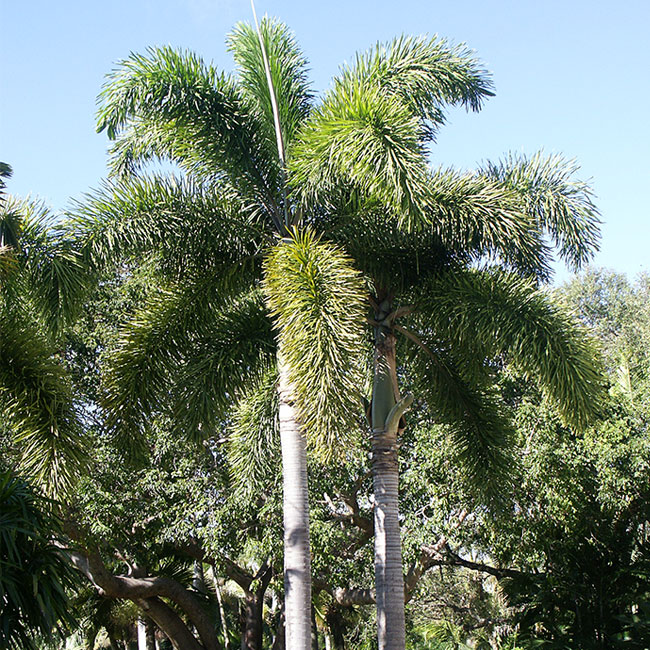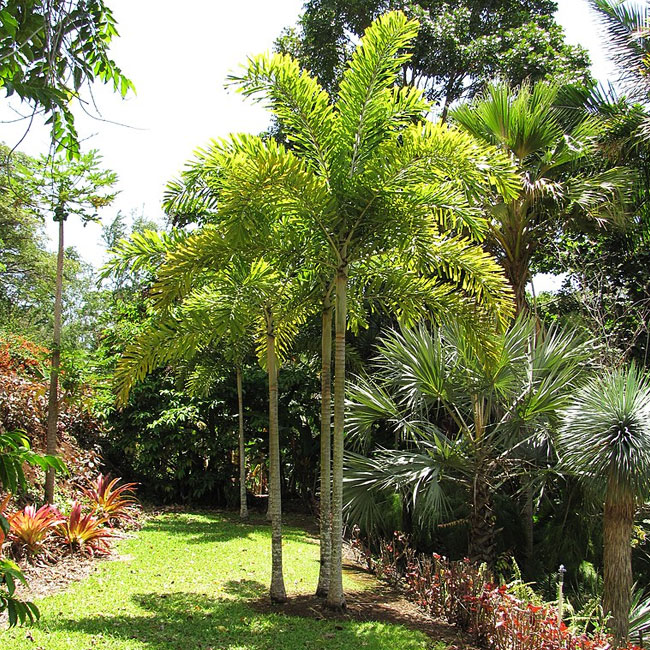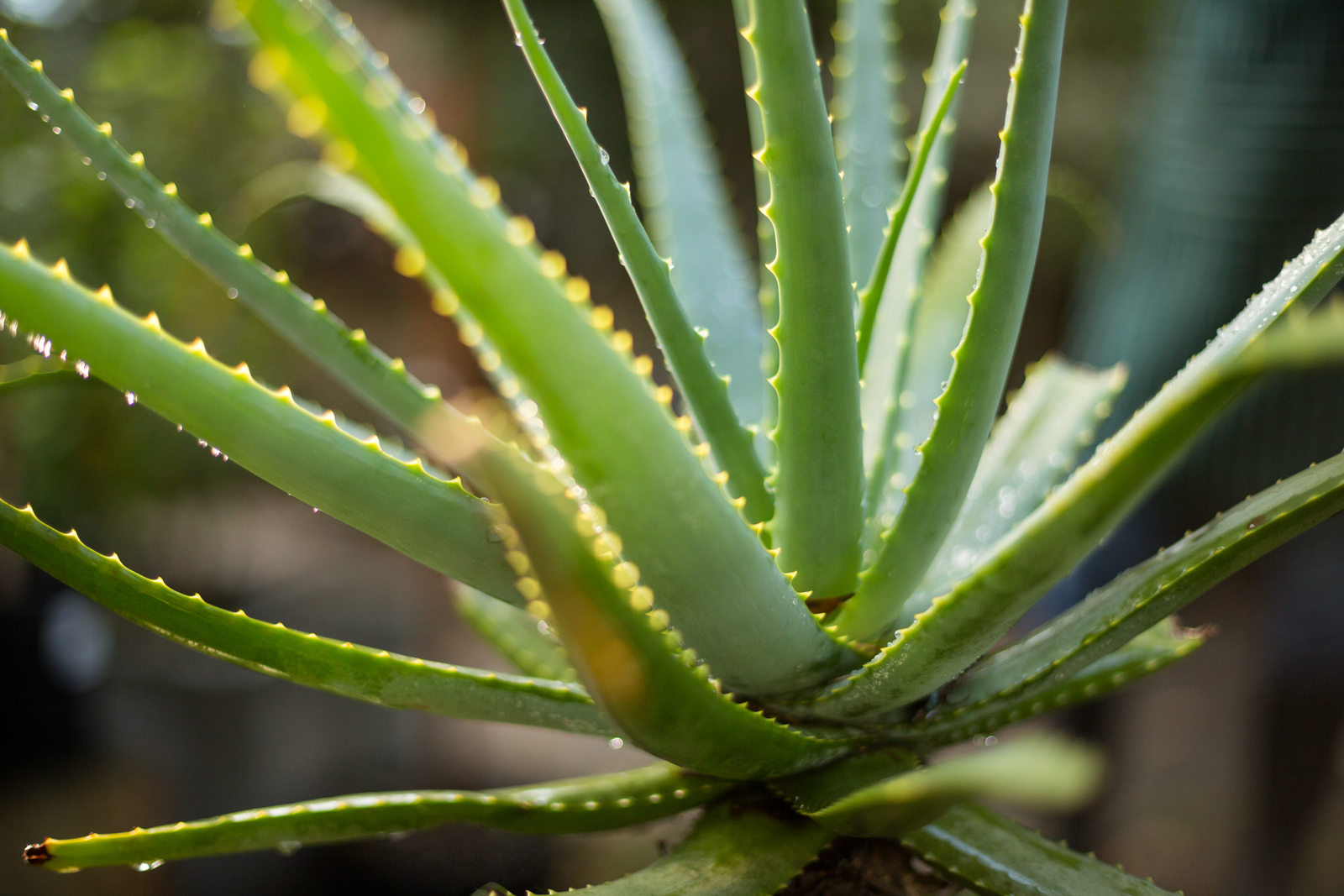Foxtail Palm – Arching, Tail-Like Fronds
The Foxtail Palm tree, also known as Wodyetia bifurcata, is a magestic, fast-growing palm native to Australia. This palm tree can grow up to 40 feet tall with a spread of 15 – 20 feet wide.
The smooth, light-gray to light-brown trunk is 12 to 18 inches in diameter, thicker at the base. The crownshaft is 3 feet tall, bluish green in color. The crown is formed by eight to ten arching evergreen fronds that emerge from the crownshaft.
Wodyetia bifurcata looks similar to Royal Palm (Roystonea regia); however it is not as massive. Partial shade is sufficient in subtropical and tropical climates when this palm is young, full sun exposure when older.

Foxtail Palm (Wodyetia bifurcata). Photo by Scott Zona, Flickr
This palm tree grows quickly. It can start as an indoor plant; however, it will eventually need to be transplanted outside. A full-grown tree will reach a height of up to 40 feet. Pruning is not required since this palm is self-cleaning and drops leaves naturally. The leaves turn from green to yellow, fade and fall from the tree. Growing and caring for Wodyetia bifurcata is easy with proper planting, watering and feeding.

Foxtail Palm (Wodyetia bifurcata). Photo by Forest and Kim Starr, Wiki Commons
Growing Foxtail Palm – Basic Care and Information
Foxtail palm trees add majestic tropical appeal to residential and commercial landscape designs. Specimens can be planted in groups as a mass planting, or featured as a focal point in the landscape.
Several trees can be planted in a row along a driveway or winding road in large residential and commercial landscapes. This fast growing palm thrives in full sun to partial shade. It grows best in well-drained, sandy soil that is slightly acidic.
Tips for Planting
USDA Hardiness Zone – Can be planted year-round in zones 10 – 11.
Location – Choose a location that receives partial to full sun – full sun is ideal. The location should be large enough to accommodate full growth.
Choose a spot where the full height of the plant will not interfere with power lines or other overhead obstructions. Allow a minimum of ten to twelve feet between plantings.
Soil – Wodyetia bifurcata likes sandy, well-draining soil.
Steps for Planting
Choose a location that receives partial to full sun; one that will accommodate the height and spread of the palm tree.
- Dig a hole twice as wide as the root ball. Note: The hole should be as deep as the root ball is tall. The soil surrounding the roots should be loose to allow for easy establishment.
- Use a shovel and score the sides of the hole to loosen the dirt. This will help the roots to penetrate through the soil in its new home. Mix the soil from the hole and the pot the tree came in with sand to create a mix of 2 parts soil, 1 part sand. This will allow for proper drainage.
- Add a small amount of water to the bottom of the hole and shovel in a thin layer of the soil mixture. This will help reduce the shock to the palm tree when it is planted.
- Get the roots of the palm wet and place it in the center of the hole – make sure the tree is standing straight. Fill the hole halfway with soil and pack firmly. Fill in the hole with the remaining soil and sand mixture while packing firmly around the base of the palm tree.
- Add three inches of organic mulch around the palm tree. Water the plant thoroughly. Large, newly planted palm trees may need to be protected from winds and storms by using a brace.
- Water thoroughly after planting is completed. Newly planted palms like lots of water. For the first two to three weeks, water daily. Continue watering three times a week. Once established, palms require minimal watering. During the warmer months, water palm tree approximately two to three times per week. Water approximately once a week during the winter.
- Apply a light application of controlled-release fertilizer 3 – 4 months after transplanting. When new leaves start to appear, a regular fertilization schedule should be established. A fertilizer rich in micronutrients that contains slow-release potassium is ideal.
Growth rate will be slow after transplantation as the plant acclimates to its new environment. Specimen-sized foxtails will dedicate most of their energy to new root growth.
Note: Choose the location wisely; transplanting palm trees once they are established is risky.
Palm Tree Care
Water
Requires consistently moist soil; do not let dry palm out between watering. Water Foxtail palm occasionally during cool months.
Fertilizer
Apply a light application of controlled-release fertilizer 3 – 4 months after transplanting. When new leaves start to appear, a regular fertilization schedule should be established. A fertilizer rich in micronutrients that contains slow-release potassium is ideal.
Fertilize Foxtail palm trees during the growing season (approximately three to four applications). A single application of a high-quality, continual-release formula (rich in micronutrients) that contains slow-release potassium will feed palm trees for a few months at a time. Apply fertilizer to the soil in a large ring at least 2 foot from the trunk.
Do not fertilize newly planted palm trees regularly until new growth appears – approximately six to eight weeks after planting.
Propagation
Propagate Wodyetia bifurcata by seeds. Germination occurs in three to six months.
- Home
- Palm Tree Species
- Foxtail Palm



